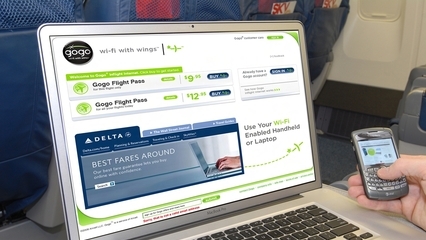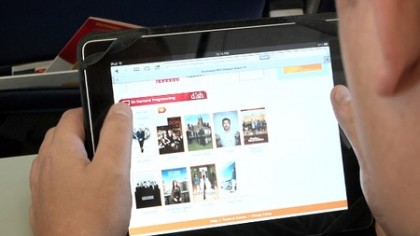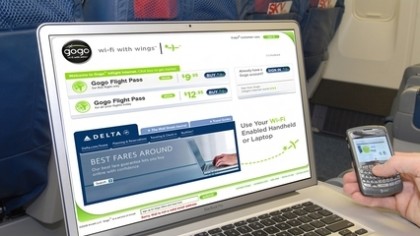Forget flight mode: how gadgets are set to change air travel forever
Where we're going, we won't need flight mode

The phrase that brings dread at the start of a flight: "Please turn off all electronic devices during take-off and landing. Limited use is allowed during the flight."
That wasn't so bad when all you had to do was switch off your Gameboy for a bit (although the lack of saving RUINED Super Mario Land) but nowadays, in our smartphone-addicted times, it's akin to being imprisoned in the 1980s for umpteen hours.
It means flights are dead time, with no communication with the outside world, limited ability to work or play and during take-off and landing you were all but forced to read the in-flight magazine, which is a fate we wouldn't wish on anyone.
There were reasons for this, beyond perhaps the hope that passengers might resort to overpriced alcohol in desperation.
Take-off and landing are the most dangerous parts of a flight. If anything's going to go wrong it's likely to happen during your ascent or descent, so airline staff want you to pay attention to the safety information and not be distracted.
There were also concerns that electronic devices might interfere with radio frequencies used by the cockpits navigation and communication equipment or degrade the signal strength of landing systems.

The times they are a-changin'
But things are finally changing, as it turns out that electronics might not be such an issue after all. Some US airlines recently carried out a series of tests which showed that electronic devices don't actually affect a plane's systems and restrictions are being lessened as a result.
Sign up for breaking news, reviews, opinion, top tech deals, and more.
What does that mean for passengers? Well first of all you may soon be able to use phones, tablets, e-readers and other handheld devices during take-off and landing.
The UK's Civil Aviation Authority has already allowed BA to make the change and other airlines might soon follow.
This means on British Airways flights you no longer have to turn electronics off before boarding or before the descent, instead simply switching them to aeroplane mode and they can stay on for the duration of the flight.
That applies to any handheld item that has a flight safe mode, though larger devices such as laptops can still only be used when the plane is cruising, which is more to do with keeping the seating area clear in the event of an accident.
The relaxation of restrictions also means less downtime as you'll actually be able to use your phone and tablet during take-off and landing, giving you an average of 30 minutes extra use on every flight.
It's a change which airlines seem to be happy about too. Madhu Unnikrishnan, a media relations manager for Virgin America, told us that "the FAA [previously] restricted the use of personal electronic devices (PED's) during take off and landing, and we complied with the rules. We are pleased that the agency has relaxed the rules to allow the use of PED's from gate to gate."
The fact that people are using personal electronics more and have more freedom to use them has also played into a rethink on in-flight entertainment.
For example Lufthansa has created a service which will stream movies, music and other content straight to passengers phones and tablets, removing the need to have screens built into planes and improving the quality of what you're watching - if you invest in a new smartphone or tablet with a decent screen, of course.

Wi-Fly
Even better, Wi-Fi is now available on some flights. For example BA offers it through its currently rather exclusive and limited OnAir service, keeping passengers connected to their world for the duration of a flight.
In the US, on-board Wi-Fi is more widely available. It's a common feature of domestic flights, where there's a hotspot on board the plane, which transmits to specially built mobile phone masts on the ground.
Since whatever device you're using is connecting to the plane rather than directly communicating with antennas on the ground it doesn't interfere with normal phone masts, while the masts that the aircraft communicates with operate at a lower transmitting power than normal ones, to avoid any interference with the plane's navigation systems.
There are still problems to overcome though; for one thing there tends to be a cost attached to the service, which can put people off. Then there's the fact that heavy Wi-Fi use could drain your battery, especially on long flights, yet many planes still don't have power sockets for every seat.
On-board Wi-Fi also poses problems for international travel, as right now it relies on more of a 3G / 4G hotspot on the plane (if available - many are still stuck on 2G / EDGE, which are nigh-on useless to most connected phones), which requires passengers to use data roaming and can have major costs attached.

Phoning home from 30,000 feet
It's an exciting step in the right direction though. It's bringing the in-flight experience into the 21st century and allowing your time on board to be less boring and more productive.
The one thing that's still mostly not allowed is phone calls, but airlines are even starting to experiment with that, although there are obvious barriers.
Mobile phone masts don't broadcast very far upwards, not to mention the fact that planes travel so fast that even if you could get a connection it would likely cut out as you move between towers, so even if you were allowed to use your phone on a plane you wouldn't actually be able to make calls the way things are now.
But the solution is simple: airlines would just have to install a 'picocell' on the plane, which is a small cellular base station that basically does the same job as a mobile phone mast.
Then the only hurdle is to ensure that passenger's phones connect to the network at their lowest setting, so as not to interfere with the on-board electronics. But new technologies have solved that problem and some airlines have already implemented them.
Virgin Atlantic for example is experimenting with in-flight calls, while text messages are already sort of possible on Wi-Fi equipped planes, as Unnikrishnan told us that "we do not permit voice calls on board our flights, but guests may send text messages when connected to Wi-Fi through apps, such as iMessage and WhatsApp."
So what does all this mean for aeroplane mode? Well, where it once turned off all connections it may soon be redesigned to allow for Wi-Fi and in the not too distant future it may not be needed at all.
What do you think? Should we lament the loss of that peaceful flight time, or will the end of rubbish screens, lonely hours in the air and nothing but the hiss of the engines be a wonderful thing? Let us know in the comments below.
Drones, clones and no-fly zones: how robot aircraft are taking over the world
James is a freelance phones, tablets and wearables writer and sub-editor at TechRadar. He has a love for everything ‘smart’, from watches to lights, and can often be found arguing with AI assistants or drowning in the latest apps. James also contributes to 3G.co.uk, 4G.co.uk and 5G.co.uk and has written for T3, Digital Camera World, Clarity Media and others, with work on the web, in print and on TV.